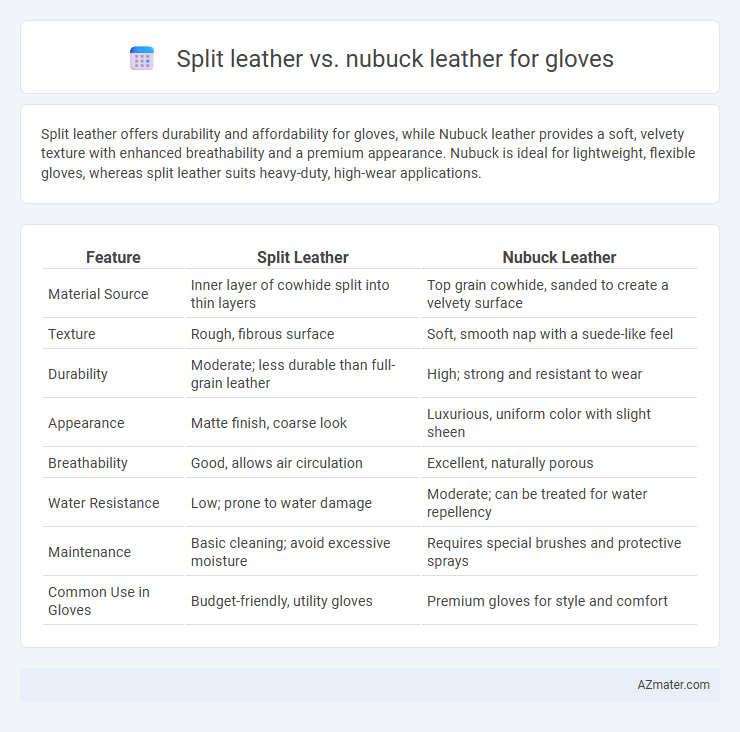Split leather offers durability and affordability for gloves, while Nubuck leather provides a soft, velvety texture with enhanced breathability and a premium appearance. Nubuck is ideal for lightweight, flexible gloves, whereas split leather suits heavy-duty, high-wear applications.
Table of Comparison
| Feature | Split Leather | Nubuck Leather |
|---|---|---|
| Material Source | Inner layer of cowhide split into thin layers | Top grain cowhide, sanded to create a velvety surface |
| Texture | Rough, fibrous surface | Soft, smooth nap with a suede-like feel |
| Durability | Moderate; less durable than full-grain leather | High; strong and resistant to wear |
| Appearance | Matte finish, coarse look | Luxurious, uniform color with slight sheen |
| Breathability | Good, allows air circulation | Excellent, naturally porous |
| Water Resistance | Low; prone to water damage | Moderate; can be treated for water repellency |
| Maintenance | Basic cleaning; avoid excessive moisture | Requires special brushes and protective sprays |
| Common Use in Gloves | Budget-friendly, utility gloves | Premium gloves for style and comfort |
Introduction to Split Leather and Nubuck Leather
Split leather is derived from the lower layers of a hide after the top grain has been separated, offering a rougher texture and enhanced durability for glove use. Nubuck leather is created by buffing the outer grain surface to produce a soft, velvety finish that combines aesthetics with moderate strength. Both materials provide distinct tactile qualities suited for gloves, with split leather favoring rugged functionality and nubuck emphasizing comfort and style.
What is Split Leather?
Split leather is derived from the lower layers of a hide after the top grain has been separated, offering a coarse texture and increased durability, making it suitable for heavy-duty gloves. Unlike nubuck leather, which is made from the top grain and sanded to create a soft, velvety surface, split leather provides a tougher, more affordable option with less flexibility. This material is commonly used in work gloves where abrasion resistance and strength are critical.
What is Nubuck Leather?
Nubuck leather is a type of top-grain leather that is sanded or buffed on the outer surface to create a slight nap, giving it a soft, velvety texture often used in gloves for enhanced comfort and breathability. Unlike split leather, which is derived from the lower layers of the hide and lacks durability, nubuck maintains strength and durability while offering a more refined appearance. The fine grain structure of nubuck leather provides a balance of suppleness and resilience, making it a premium material choice for high-quality gloves.
Key Differences: Split Leather vs Nubuck Leather
Split leather is created from the lower layer of a hide and has a rougher texture, offering greater durability but less flexibility compared to nubuck leather, which is made from the outer layer of the hide and features a soft, velvety surface due to its sanding and buffing process. Nubuck leather provides superior breathability and a more luxurious feel, making it ideal for gloves that require comfort and style, while split leather is better suited for heavy-duty gloves needing robust protection. The main differences between split leather and nubuck leather lie in their thickness, texture, durability, and suitability for different types of glove applications.
Durability Comparison for Glove Use
Split leather gloves offer high durability due to their firm structure and resistance to tearing, making them ideal for heavy-duty tasks. Nubuck leather gloves, while softer and more flexible, tend to wear faster because the sanding process weakens the surface fibers. For prolonged glove use in demanding environments, split leather outperforms nubuck in longevity and abrasion resistance.
Comfort and Flexibility in Gloves
Split leather offers durability and moderate flexibility for gloves but tends to be stiffer and less breathable compared to nubuck leather. Nubuck leather provides superior softness, enhanced comfort, and better flexibility due to its finely sanded grain surface, making gloves more comfortable for extended wear. The breathable nature of nubuck leather also reduces hand sweat, improving overall glove comfort during prolonged use.
Appearance and Aesthetic Appeal
Split leather displays a rough, coarse texture with visible grain patterns, providing a rugged and durable appearance ideal for work gloves. Nubuck leather, sanded on the outer side, offers a soft, velvety finish with a rich, matte sheen, enhancing the glove's aesthetic appeal with a premium and sophisticated look. The unique texture of nubuck leather ages gracefully, developing a natural patina that adds character over time, whereas split leather maintains a more utilitarian and sturdy visual impression.
Maintenance and Care Requirements
Split leather gloves require regular conditioning with leather balms to prevent cracking and maintain flexibility, while Nubuck leather gloves need specialized suede cleaners and gentle brushing to preserve their soft, velvety texture. Both types benefit from avoiding prolonged exposure to water and direct sunlight to reduce damage and fading. Proper storage in a cool, dry place ensures longevity and prevents mold or stiffness in either leather type.
Cost and Affordability Factors
Split leather gloves tend to be more affordable than nubuck leather gloves due to their production process, as split leather is made from the lower layers of the hide. Nubuck leather involves more intensive sanding and finishing techniques, increasing its cost and making it a premium option. For budget-conscious buyers, split leather gloves offer durability and decent performance, while nubuck gloves provide a softer feel and higher aesthetic appeal at a higher price point.
Which Leather is Best for Gloves?
Split leather offers durability and resistance, making it ideal for heavy-duty gloves used in industrial or construction settings. Nubuck leather provides a soft, velvety texture with excellent breathability and flexibility, preferred for gloves requiring comfort and a premium finish. Choosing the best leather depends on the glove's intended use: split leather excels in protection and longevity, while nubuck is favored for comfort and style.

Infographic: Split leather vs Nubuck leather for Glove
 azmater.com
azmater.com